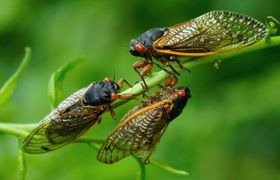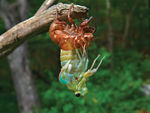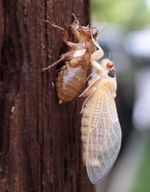Periodical Cicadas
Periodical Cicadas

Periodical cicadas of eastern Northern America fall within the genus Magicicada. This 13-year and 17-year species are often referred to as “locusts” which is incorrect. Cicadas fall into the order Hemiptera while locusts fall into the order Orthoptera like grasshoppers [1].
The 13 and 17-year life cycles of cicadas are spent primarily underground where they consume the xylem from the roots of eastern U.S. deciduous trees [2]. Mature cicada nymphs crawl up to the surface and emerge in the springtime after 13 or 17 years simultaneously in massive numbers. These mature adults are only active for about 4 to 6 weeks after emergence [3]. To attract mates, males conglomerate and vocalize, creating a noisy chorus. This lifecycle is finished after about 2 months from the initial emergence, where at this point the adult cicadas are absent for another 13 or 17-year period and the eggs have been laid.
Description
The periodical cicada has a black dorsal thorax, red eyes, and translucent wings with orange veins. Depending on the species, the abdomen underside can be black, orange, or striped with orange and black [4].
Adults are usually 2.4 to 3.3 cm, which is a little smaller than most annual cicada species found within the same habitats in the United States. Females are larger than males at maturity [5].
Males of the Magicicada attract females by forming large aggregations that “sing” in a chorus. This chorus typically sounds like loud buzzing, ticking, or both. The characteristics of these chorus “songs” vary depending on the species [6].
Cicadas are not known for biting or stinging. They have mouthparts that are used to pierce plants and suck their sap like other Auchenorrhyncha bugs. The only way a cicada can be harmful is that when being handled their proboscis can painfully pierce human skin. There is no evidence that they transmit disease and are venomous. Mature vegetation experience little threat from periodical cicadas, but planting new trees and shrubs is better to be pushed off until after their expected emergence. Twig die-off or flagging can result from egg-laying [7]. To prevent damage to young trees or shrubs during the egg-laying period, which starts a week after emergence of the first adult and lasts until females have died, they can be covered with cheesecloth or another similar material.
Lifecycle




Every cicada spends many years as a juvenile underground, but then emerges aboveground for a small adult period that can last several weeks to a few months. All the adults of the 7 periodical cicada species emerge in any one location all at once in the same year, in a synchronized fashion. Annual cicadas are not synchronized; some adults mature every summer while the rest of the population develops underground.
During the juvenile stage periodical cicada nymphs live underground within 2 ft of the surface and feed on plant root juices [8]. These nymphs in their underground development undergo 5 instar stages (arthropod developmental stages). The difference in the 13 and 17-year lifecycle is the time taken for the maturity of the second instar. As the nymphs feed they move deeper below ground to get to larger roots during their time underground [9].
Nymphs emerge when the soil temperature at about 20 cm deep is above 17.9 °C in the spring. The time of the emergence varies depending on location. In the far south the emergence occurs in late April or early May. In the far north they emerge late May to early June. When they emerge, nymphs move to complete their transformation into adults by climbing to a suitable place on nearby vegetation. After their final molt, they spend 6 days in the trees waiting for the hardening of their exoskeletons to complete.
As adults, periodical cicadas only live for a few weeks; having disappeared by mid-July. Their adult lives are short lived, with the singular purpose of reproduction. Using their tymbals, males “sing” a species-specific mating song. When males vocalize they usually aggregate together which is sexually attractive to females. These males alternate singing and short flights from tree to tree to find females [10].
Receptive females respond to these males with timed wing-flicks that attract them for mating [11]. The sound created by a chorus can reach a deafening 100 decibels. Other than their calling song, when approaching an individual female males produce a courtship song that is distinctive [4]. Mating can happen multiple times for both males and females, but females mostly mate just once. After mating, the female cuts V-shaped slits in bark of young twigs and lays around 20 eggs in each slit. The overall total each year is around 600 or more eggs. The eggs hatch into newborn nymphs that drop to the ground after about 6 to 10 weeks, where they then burrow into the ground to start another 13 or 17-year cycle.
Survival Strategy
Predator Satiation
Cicada nymphs emerge synchronously in large numbers, more than 1.5 million individuals per acre sometimes [12]. This large emergence is a survival trait called predator satiation. Early after their emergence, the periodical cicadas are easy prey for birds, reptiles, cats, and other small and large mammals [3]. The overall survival mechanism of the cicadas is just to simply overwhelm predators with their large numbers, allowing for most individuals to survive. Their large population sizes before emergence is most likely a predator avoidance strategy. This is adopted to eliminate the possibility of predators having periodic population boosts that would be synchronized with the cicada emergence [13]. Another view of why their developmental period is so long is to prevent hybridization between broods of differing cycles. This adaptation most likely resulted from cycles during a period of heavy selection pressure that were brought on by lowered and isolated populations [14].
Cicada population cycles are momentous enough to affect other animals and plants. Tree growth has been observed to decrease the year before the emergence of a cicada brood, due to the increased eating by nymphs on roots [15]. The mole uses them as a food source and has shown to do well the year before an emergence, but do poorly the following year due to the reduced source of food [16]. The carcasses that are uneaten decompose on the ground providing nutrients to the soil [15].
Distribution
The 17-year cicadas are found across the eastern, upper Midwestern, and Great Plains states of the U.S.. With some overlap, the 13-year cicadas are found in the southern and Mississippi Valley States. Efforts are currently underway to generate new distribution maps of all periodical cicada broods. This effort makes use of crowdsourced records and records collected by entomologists [17].
References
[1]"Periodical Cicada". magicicada.org.
[2] Lloyd, M. & H.S. Dybas (1966). "The periodical cicada problem. I. Population ecology". Evolution. 20 (2): 133–149. doi:10.2307/2406568. JSTOR 2406568.
[3] Williams, K.S. & C. Simon (1995). "The ecology, behavior, and evolution of periodical cicadas" (PDF). Annual Review of Entomology. 40: 269–295. doi:10.1146/annurev.en.40.010195.001413.
[4] Alexander, Richard D.; Moore, Thomas E. (1962). "The Evolutionary Relationships of 17-Year and 13-Year Cicadas, and Three New Species (Homoptera, Cicadidae,Magicicada)" (PDF). University of Michigan Museum of Zoology. Retrieved 9 June 2011.
[5] Capinera, John L. (2008). Encyclopedia of Entomology. Springer. pp. 2785–2794. ISBN 1-4020-6242-7.
[6] Stranahan, Nancy. "Nature Notes from the Eastern Forest". Arc of Appalachia. Archived from the originalon 5 October 2011. Retrieved 10 June 2011.
[7] Cook, William M.; Robert D. Holt (2002). "Periodical cicada (Magicicada cassini) oviposition damage: visually impressive yet dynamically irrelevant" (PDF). American Midland Naturalist. 147 (2): 214–224. doi:10.1674/0003-0031(2002)147[0214:PCMCOD]2.0.CO;2. Archived from the original (PDF) on 7 August 2011.
[8] Marlatt, C. L. (1907). The Periodical Cicada (Bulletin No. 71 - U.S. Department of Agriculture, Bureau of Entomology). Washington, D.C.: United States Government Printing Office. pp. 123–125.
[9] White, J; Lloyd, M. (1979). "Seventeen year cicadas emerging after eighteen years-a new brood?". Evolution. 33: 1193–1199. doi:10.2307/2407477.
[10] "Magicicada Broods III and XXII will emerge in 2014". www.magicicada.org.
[11] "Sexual Signals in Periodical Cicadas" (PDF). Behaviour.
[12] Dybas, H. S.; Davis, D. D. (1962). "A populations census of seventeen-year periodical cicadas (Homoptera: Cicadidae: Magicicada)". Ecology. 43 (3): 432–444. doi:10.2307/1933372. JSTOR 1933372.
[13] Goles, E.; Schulz, O.; Markus, M. (2001). "Prime number selection of cycles in a predator-prey model". Complexity. 6 (4): 33–38. doi:10.1002/cplx.1040.
[14] Cox, R. T. & C. E. Carlton (1988). "Paleoclimatic influences in the evolution of periodical cicadas (Homoptera: Cicadidae: Magicicada spp.)". American Midland Naturalist. 120 (1): 183–193. doi:10.2307/2425898. JSTOR 2425898.
[15] Yang, Louie H. (2004). "Periodical cicadas as resource pulses in North American forests". Science. 306(5701): 1565–1567. Bibcode:2004Sci...306.1565Y. doi:10.1126/science.1103114. PMID 15567865.
[16] National Geographic: Cicada Outbreaks Linked to Other Animals' Booms, Busts.
[17] http://www.magicicada.org
[18] https://www.youtube.com/watch?v=EWr8fzUz-Yw
[19] Insects, their way and means of living, R. E. Snodgrass. http://www.archive.org/details/39088001578236
[20] https://commons.wikimedia.org/wiki/File:Cicada_Molting.jpg
[21] http://bugoftheweek.com/blog/2013/6/10/egg-laying-in-the-treetops-imagicicadai-brood-ii
[22] http://plotfiftyfive.blogspot.com/2016/05/magicicada.html